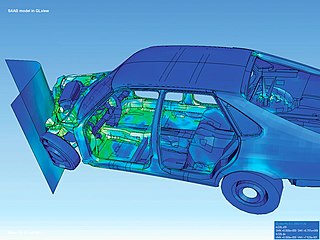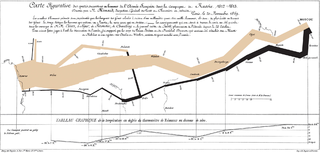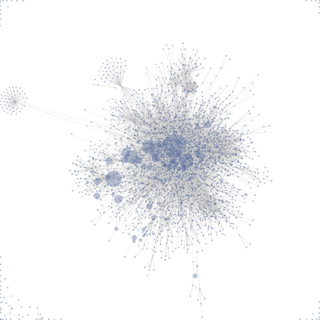Related Research Articles
In computer science, human–computer interaction, and interaction design, direct manipulation is an approach to interfaces which involves continuous representation of objects of interest together with rapid, reversible, and incremental actions and feedback. As opposed to other interaction styles, for example, the command language, the intention of direct manipulation is to allow a user to manipulate objects presented to them, using actions that correspond at least loosely to manipulation of physical objects. An example of direct manipulation is resizing a graphical shape, such as a rectangle, by dragging its corners or edges with a mouse.

Visualization, also known as Graphics Visualization, is any technique for creating images, diagrams, or animations to communicate a message. Visualization through visual imagery has been an effective way to communicate both abstract and concrete ideas since the dawn of humanity. from history include cave paintings, Egyptian hieroglyphs, Greek geometry, and Leonardo da Vinci's revolutionary methods of technical drawing for engineering purposes that actively involve scientific requirements.
The following outline is provided as an overview of and topical guide to human–computer interaction:

Ben Shneiderman is an American computer scientist, a Distinguished University Professor in the University of Maryland Department of Computer Science, which is part of the University of Maryland College of Computer, Mathematical, and Natural Sciences at the University of Maryland, College Park, and the founding director (1983-2000) of the University of Maryland Human-Computer Interaction Lab. He conducted fundamental research in the field of human–computer interaction, developing new ideas, methods, and tools such as the direct manipulation interface, and his eight rules of design.
Stuart K. Card is an American researcher and retired senior research fellow at Xerox PARC. He is considered to be one of the pioneers of applying human factors in human–computer interaction. With Jock D. Mackinlay, George G. Robertson and others he invented a number of information visualization techniques. He holds numerous patents in user interfaces and visual analysis.
Geovisualization or geovisualisation, also known as cartographic visualization, refers to a set of tools and techniques supporting the analysis of geospatial data through the use of interactive visualization.

Data and information visualization is the practice of designing and creating easy-to-communicate and easy-to-understand graphic or visual representations of a large amount of complex quantitative and qualitative data and information with the help of static, dynamic or interactive visual items. Typically based on data and information collected from a certain domain of expertise, these visualizations are intended for a broader audience to help them visually explore and discover, quickly understand, interpret and gain important insights into otherwise difficult-to-identify structures, relationships, correlations, local and global patterns, trends, variations, constancy, clusters, outliers and unusual groupings within data. When intended for the general public to convey a concise version of known, specific information in a clear and engaging manner, it is typically called information graphics.

Patrick M. Hanrahan is an American computer graphics researcher, the Canon USA Professor of Computer Science and Electrical Engineering in the Computer Graphics Laboratory at Stanford University. His research focuses on rendering algorithms, graphics processing units, as well as scientific illustration and visualization. He has received numerous awards, including the 2019 Turing Award.

Prefuse is a Java-based toolkit for building interactive information visualization applications. It supports a rich set of features for data modeling, visualization and interaction. It provides optimized data structures for tables, graphs, and trees, a host of layout and visual encoding techniques, and support for animation, dynamic queries, integrated search, and database connectivity.

Visual analytics is a multidisciplinary science and technology field that emerged from information visualization and scientific visualization. It focuses on how analytical reasoning can be facilitated by interactive visual interfaces.
George G. Robertson is an American information visualization expert and senior researcher, Visualization and Interaction (VIBE) Research Group, Microsoft Research. With Stuart K. Card, Jock D. Mackinlay and others he invented a number of Information Visualization techniques.
Tableau Software, LLC is an American interactive data visualization software company focused on business intelligence. It was founded in 2003 in Mountain View, California, and is currently headquartered in Seattle, Washington. In 2019, the company was acquired by Salesforce for $15.7 billion. At the time, this was the largest acquisition by Salesforce since its foundation. It was later surpassed by Salesforce's acquisition of Slack.
The Information visualization reference model is an example of a reference model for information visualization, developed by Ed Chi in 1999, under the name of the data state model. Chi showed that the framework successfully modeled a wide array of visualization applications and later showed that the model was functionally equivalent to the data flow model used in existing graphics toolkits such as VTK.
Maureen C. Stone is an American computer scientist, specializing in color modeling.

Jean-Daniel Fekete is a French computer scientist.
Tamara Macushla Munzner is an American-Canadian scientist. She is an expert in information visualization who works as a professor of computer science at the University of British Columbia (UBC).

Catherine Plaisant is a French/American Research Scientist Emerita at the University of Maryland, College Park and assistant director of research of the University of Maryland Human–Computer Interaction Lab.
The IEEE Visualization Conference (VIS) is an annual conference on scientific visualization, information visualization, and visual analytics administrated by the IEEE Computer Society Technical Committee on Visualization and Graphics. As ranked by Google Scholar's h-index metric in 2016, VIS is the highest rated venue for visualization research and the second-highest rated conference for computer graphics over all. It has an 'A' rating from the Australian Ranking of ICT Conferences, an 'A' rating from the Brazilian ministry of education, and an 'A' rating from the China Computer Federation (CCF). The conference is highly selective with generally < 25% acceptance rates for all papers.
Jessica Hullman is a computer scientist and the Ginni Rometty professor of Computer Science at Northwestern University. She is known for her research in Information visualization and Uncertainty quantification.
Niklas Elmqvist is a Swedish-American computer scientist. He is currently a professor in the Department of Computer Science at Aarhus University, and a Villium Investigator. He is the Director of the Center for Anytime Anywhere Analytics at Aarhus University, a research center on augmented reality and extended reality (AR/XR) for data visualization.
References
- 1 2 3 4 "Jock Mackinlay | Tableau Research". research.tableau.com. Retrieved 2017-12-31.
- ↑ "Jock Mackinlay LinkedIn". LinkedIn.
- ↑ "Google Patents". patents.google.com. Retrieved 2017-12-31.
- ↑ "VL 2000: Hints for submitting successful research papers". web.engr.oregonstate.edu. Retrieved 2017-12-31.
- ↑ 2005-10-11: Jock D. Mackinlay wins DMReview's data visualization competition. Retrieved 7 July 2008.
- ↑ "visualization technical awards | vgtc.org". vgtc.org. Archived from the original on 2019-12-29. Retrieved 2017-12-31.
- ↑ "Jock D Mackinlay". awards.acm.org. Retrieved 2017-12-31.
- ↑ "National Academy of Engineering Elects 106 Members and 18 International Members". National Academy of Engineering. Retrieved 2023-02-07.